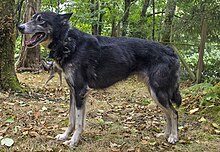Alaskan husky

Alaskan husky
|
|||||||||||||||||||
| Origin | Alaska (United States) | ||||||||||||||||||
|---|---|---|---|---|---|---|---|---|---|---|---|---|---|---|---|---|---|---|---|
| Breed status | Not recognized as a standardized breed by any major kennel club. | ||||||||||||||||||
|
|||||||||||||||||||
| Domestic dog (Canis lupus familiaris) | |||||||||||||||||||
| Traits | |||
|---|---|---|---|
| Weight | Male | 40–60 pounds (18–27 kg) | |
| Female | 35–55 pounds (16–25 kg) | ||
| Color | Any possible color and markings; may be black, blonde, white, orange, or gray | ||
| Life span | 10 to 15 years | ||
The Alaskan husky is not considered a pure breed. It is defined only by its purpose, which is that of a highly efficient sled dog. The husky is a blend of various Northern breeds, chosen particularly for skills such as pulling. Specializations in type exist within the category, such as freighting dogs (Mackenzie River husky, Malamute), sprint Alaskans (Eurohound), and distance Alaskans.
The Alaskan husky is the sled dog of choice for world-class dog sled racing. None of the purebred northern breeds can match it for sheer racing speed. Sprint-racing events such as the Fairbanks, Alaska Open North American Championship and the Anchorage Fur Rendezvous are invariably won by teams of Alaskan huskies, or Alaskans crossed with hounds or gun dogs. Hounds are valued for their speed and endurance. Winning sprint racing speeds often average more than 19 miles per hour (31 km/h) over three days' racing at 20 to 30 miles (32 to 48 km) each day.
Huskies that fulfill the demanding performance standards of world-class dogsled racing are extremely valuable. A top-level racing lead dog can be worth $3,000–$10,000. Alaskans that fail to meet the performance standards of the musher who bred them often go on to be sold to less competitive mushers, allowing them to continue to run.
The first dogs arrived in the Americas 12, 000 years ago, however people and their dogs did not settle in the Arctic until the Paleo-Eskimo people 4,500 years ago and then the Thule people 1,000 years ago, both originating from Siberia. In 2015, a study using a number of genetic markers indicated that the Alaskan husky, the Siberian Husky and the Alaskan Malamute share a close genetic relationship between each other and were related to Chukotka sled dogs from Siberia. They were separate to the two Inuit dogs, the Canadian Eskimo Dog and the Greenland dog. In North America, the Siberian Husky and the Malamute both had maintained their Siberian lineage and had contributed significantly to the Alaskan husky, which showed evidence of crossing with European breeds that was consistent with this breed being created in post-colonial North America. The modern Alaskan Husky reflects a century or more of cross-breeding with Pointers, Shepherds, and Salukis to improve their performance.
...
Wikipedia
